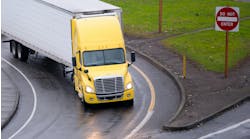INDIANAPOLIS. Fleets that haven’t already made the transition to ELDs could have some unpleasant surprises in store, panelists at the 2017 FTR Transportation Conference explained here Tuesday. Issues include lost productivity, driver turnover, customer expectations, the availability of ELD units, and even whether or not the units will perform as advertised—and as required by the regulations.
With legal challenges and legislative attempts at a rollback having run their course, the “wait-and-see” uncertainty about the Dec. 18 implementation date is finally past, explained carrier safety consultant and former Federal Motor Carrier Safety Administrator Annette Sandberg. But those who have held out are going to have to scramble to become ELD compliant—and that includes “quite a few” large fleets who rely on owner-operators, she added.
“We’re going to start to see a lot of activity in this area. I’m getting a lot of questions from carriers about how to implement quickly, what vendors to pick,” Sandberg said. “But my biggest concern, as a former regulator, is the number of ELD vendors that are currently on the FMCSA ELD list that probably shouldn’t be.”
Sandberg contends that the self-certification process has allowed non-compliant devices into the marketplace—and fleets might not be aware of the problems. She told of being called in to help a 3,000 truck carrier that was concerned “something wasn’t quite right” with the ELDs it had installed.
“It was apparent at the end of the first day that this device should never have been self-certified,” she said. “It wasn’t even minimally compliant with the automatic on-board recording device (AOBRD) regulation that’s been in effect for 20 years.”
Sandberg also noted some uncertainty in the market as to whether a sufficient number of devices will be available to meet the demand over the coming weeks.
Still, worries that the implementation of the mandate will immediately cause service disruptions in the supply chain are unfounded, she explained. For starters, enforcement of the regulation will be phased in, as the Commercial Vehicle Safety Alliance (CVSA) recently announced, and non-compliant trucks will not be placed out of service until April 2018, giving carriers additional time for the transition.
“And if you read the fine print of the rule, even if a trucking company doesn’t have an ELD on their trucks, it’s going to take FMCSA a while to go in and do a compliance review before they can take strict enforcement action—either downgrading their safety rating or shutting that carrier down,” she said. “So I think it’s going to be at least a year before we start seeing some carriers slough out of the market for not having complied.”
But that delay in full enforcement is troubling to compliant fleets.
“It’s disappointing that they’re not going to be enforcing it immediately. People have had all kinds of time to get e-logged up,” said Steve Wutke, vice president of sales, refrigerated division, for Prime Inc. “It’s the right thing to do. As an asset carrier running 6,000 trucks, we think it’s a safer world that we’re in, but these guys have chosen to drag their feet and ride it out.”
Along with selecting and installing complaint devices, there’s also “an education process” that takes time—and money. But the biggest problem late adopters are going to face is “the reality of the shortfall of revenue,” Wutke continued.
“We’ve been on e-logs for five years now, and I can tell you they’re going to lose 4-7% in productivity,” he said. “Paper-log folks, they do not log properly—they cheat. I know, because when we were on paper we did. You could create a lot of extra time on your logbook. That gap in productivity is going to be huge.
“I don’t really think people are focused on that yet. It’s not the cost of getting e-logged up: There’s going to be a change in their network, a shortfall of revenue that the trucks are going to miss on weekly basis, and then there’s the driver turnover that’s going to follow. There’s going to be a huge learning curve. It just won’t happen overnight.”
In addition to the regulatory requirement, shippers and brokers are increasingly demanding ELD compliance from their carriers. Panelist Ron Guzzi, senior manager of carrier relations for Home Depot, said the company’s asset-based fleets are compliant “in 97- 98% range.”
“We consider ourselves to be an asset-based shipper, so we do very little with brokerage. This is part of the reason. We don’t feel there’s a direct impact to us, because we deal with the right carriers,” Guzzi said. “We’re also wise enough to know that when the industry is forced to have ELDs, it’s going to have an impact on utilization and lead to increased rates over the next six months. But our carriers are already there and I think we’re already paying for their adjusted utilization from when they made the changes.”
Similarly, 3PL Armada has been “proactive” and made ELDs a requirement in its network by the end of 2016, a year ahead of the FMCSA deadline, added Meredith Neizer, vice president of transportation operations.
“We have a very small part of our network that is brokered, but we now also have a requirement with our partner-brokers that had to be able to identify which of their owner-operators were ELD compliant, and ensure that our loads were tendered only to ELD-compliant owner-operators,” Neizer said. “We and our clients are big believers in the ELD mandate from a safety standpoint and from a competitive standpoint. So were well ahead of it and we’re in good shape by the time the date rolls around.”
Indeed, the immediate pressure to be ELD-compliant comes from the marketplace—customers and insurers, the panel agreed.
“We’ve had a lot of feedback from insurance carriers that tell us if a carrier isn’t e-logged up, he likely will have a hard time buying insurance—and if does, it’s going to be a nosebleed rate,” Prime’s Wutke said. “That alone will create some washout of smaller guys. I’m not belittling the smaller guys, and we need that capacity, so we need to find solutions to get through this next crunch, for sure.”





